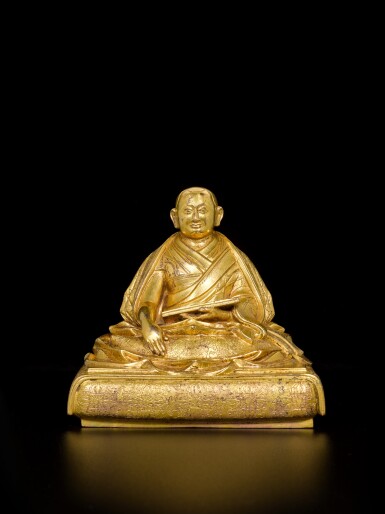Auctions
Buy Now
Collectibles & More
Books & Manuscripts
Dharma and Tantra
Dharma and Tantra

Auction Closed
September 17, 03:45 PM GMT
Estimate
100,000 - 150,000 USD
Lot Details
Description
Himalayan Art Resources item no. 1905.
Height 4⅞ in., 12.2 cm
English Private Collection, acquired prior to 1975.
༄༄། །ཐམས་ཅད་མཁྱེན་པ་ངག་དབང་བློ་བཟང་རྒྱ་མཚོའི་སྐུ་འདྲ་ཕྱག་ནས་མ།
Thams cad mkhyen pa ngag dbang blo bzang rgya mtsho'i sku 'dra phag nas ma.
Tamche khyenpa Ngawang Lobsang Gyatso'i kudra chag ne ma.
The intricately cast inscription on the reverse of the cushion translates as:
'[This] likeness is blessed by the hand of the omniscient Ngawang Lobsang Gyatso [5th Dalai Lama]. '
The inscription reveals that this exquisitely cast portrait bronze was created during the lifetime of the Fifth Dalai Lama and blessed by he himself, as opposed to being created posthumously, like the majority of extant examples. Ngawang Lobsang Gyatso (1617-82), one of the most significant figures in Tibetan political and religious history, was renowned as 'the Great Fifth' for his preeminent skills as a diplomat and politician. He was the first Dalai Lama to assume both spiritual and secular leadership (with the support of the Mongol leader Gushri Khan) within a newly unified Central Tibet. He commissioned the construction of two of the world's most awe-inspiring edifices: the Potala palace, his headquarters and monastery; and the Lukhang, his private meditation temple built within a man-made lake, illustrated with very finely executed seventeenth-century esoteric wall murals. He also is credited with engineering the demise of the aristocratic military hegemony by forcing their residency in Lhasa and bestowing key political positions upon them. Thus power was centralized in the capital under the direct auspices of Ngawang Lobsang Gyatso, establishing the dynastic government that survived in Tibet until 1959.
Ngawang Lobsang Gyatso was politically astute and an outstanding statesman, and also a prolific author of works on philosophy, meditation, history and poetry. For example, the exquisite 'Gold Manuscript' now in the Musée Guimet is a record of his tantric visions that reveal a complex understanding of Tibetan Buddhist ritual. For further discussion, see Samten Gyaltsen Karmay, Secret Visions of the Fifth Dalai Lama, London, 1988.
The form of the square cushion and the treatment of the drapery, notably the intricacy of the textiles designs on the present figure closely relate to the inscribed gilt-copper alloy figure of the Fifth Dalai Lama sold in these rooms, 13th-14th September 2016, lot 161 for an unprecedented price. See also characteristics of the current work in two other seventeenth-century sculptures: an ungilt bronze sculpture in the Museum of Fine Arts, Boston (accession no. 50.3606), and a polychromed wood sculpture previously exhibited at the Ethnographic Museum of the University of Zürich in 2005 and sold in these rooms, 19th March 2008, lot 312.
You May Also Like